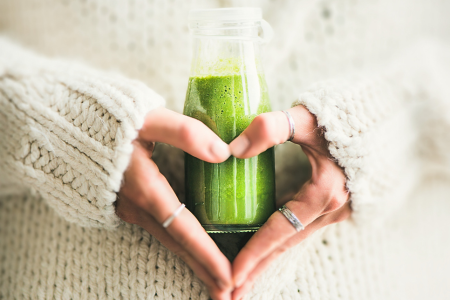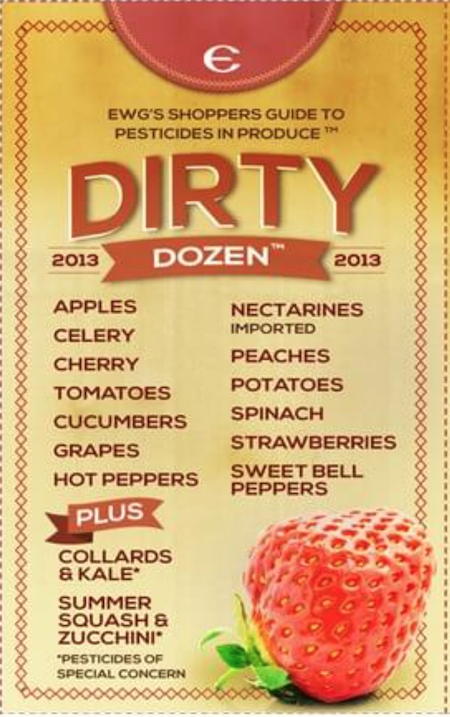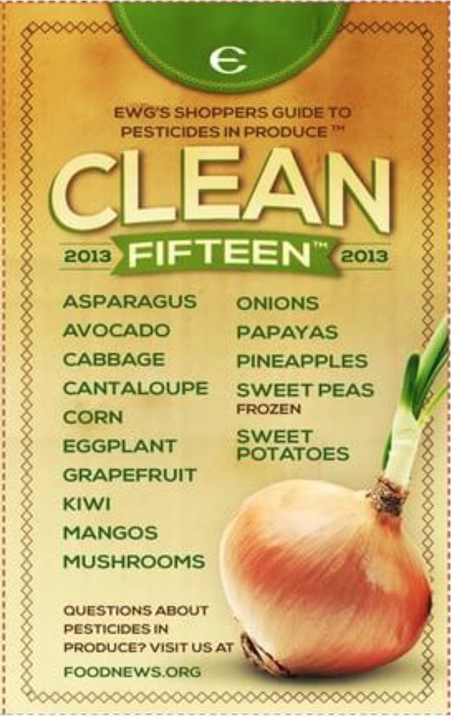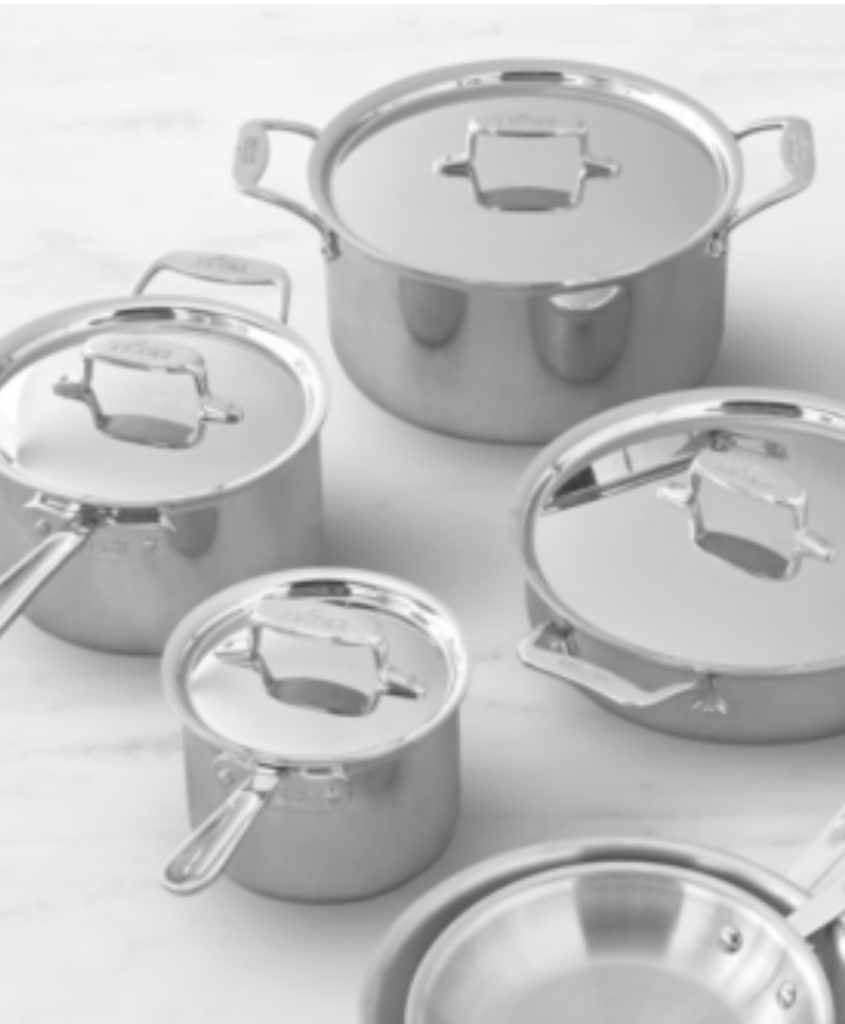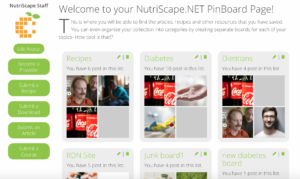Welcome to a journey that focuses not only on the miracle of life, but also on your wellbeing as a soon-to-be mother. Preparing your body for pregnancy isn’t only about prenatal vitamins and tracking ovulation cycles—it’s also about creating the healthiest environment possible for your growing baby. A key part of this preparation involves minimizing the toxic burden on your body and reducing your exposure to xenoestrogens.
This might sound daunting, but there are practical and manageable steps you can take to reduce your exposure to these unwanted chemicals and detoxify your body. As you embark on this beautiful journey towards motherhood, we offer this guide to help you improve your health, detox your body before pregnancy and provide the most nurturing environment for your tiny inhabitant. Let’s dive in!
The Problem
Sounding The Alarm: Why It Pays To Be Careful What You Eat and Drink
Few healthcare providers are aware that our water and food supply is full of chemicals of all kinds. Estrogen from birth control pills is excreted through urine and enters the water supply in cities. Forever chemicals never break down and they are everywhere in our environment. These chemicals are causing changes in the genitalia of amphibians and reptiles. When an effective dose is possibly as little at 2 drops in an Olympic size swimming pool, many scientists are worried. Forever chemicals are found in a range of everyday products from non-stick pans to water-resistant clothing and grease-resistant food packaging like popcorn bags and pizza boxes.
They can easily enter our bodies and have been detected even in the womb, crossing the placental barrier to reach the developing child. Xenoestrogens, a specific type of these chemicals, mimic estrogen in the body and can disrupt hormonal balance at critical periods during the development of the baby’s sex organs and brain. The presence of these compounds in cord blood makes scientists wonder if these chemicals are responsible for the skyrocketing rates of everything from autoimmunity to gender dysphoria. The extreme sensitivity of babies at various stages in utero makes the efforts to reduce our exposure all the more critical.
Your Liver Will Automatically Detox Your Body (But Only When Given The Right Nutrients)
Detox is poo-hoo’d by many, even those in health-care. It has this bad name because of the many charlatans selling diarrhea inducing high priced supplements that don’t address anything to do with toxins. Here’s the real story, and it is eye-opening. Although there is a tremendous amount of stuff going on in the image below, here’s what you want to know.
- Your liver begins detoxifying by first turning toxins into substances that are even more toxic. Once Phase 1 is complete, there’s a possibility that Phase 2 detoxifications move more slowly than Phase 1, allowing toxic intermediary compounds to build up.
- Your liver won’t detoxify anything unless you feed it the right nutrients.
- Phase 1 liver detoxification will not work adequately without Vitamin B2 (riboflavin), B3 (niacin), B6, Folic acid, and B12, glutathione, and those colorful substances in fruits and vegetables known as flavinoids.
- Phase 2 liver detoxification requires magnesium, cysteine, glycine, taurine, glutamine, choline and glutathione. And it requires Vitamin B5, Folic Acid, and B12.
- The “Standard American Diet” does not provide adequate nutrients to carry out detoxification processes.
- Fiber: There is not enough fiber to bind bile acids and toxins to take it out of the body through the digestive tract.
- Water: There’s not enough water to make optimal quantities of urine needed excrete waste compounds.
- B Vitamins: The B vitamins required for these reactions are used up by stress, alcohol consumption, a high-sugar diet, pregnancy and lactation, certain medications, age, physical activity, and smoking.
- Magnesium: More than half the population is failing to get adequate magnesium to support Phase 2 Detoxification.
- Weed Killer: Glyphosate slows down Phase 1 detoxification by inhibiting the cytochrome P450 enzymes. Non-organic wheat, soy, and produce are covered with glyphosate. Researchers say: “Glyphosate’s inhibition of cytochrome P450 (CYP) enzymes is an overlooked component of its toxicity”. Bread is specifically high in glyphosate due to farmers spraying glyphosate directly on wheat to dry it out days before harvest.
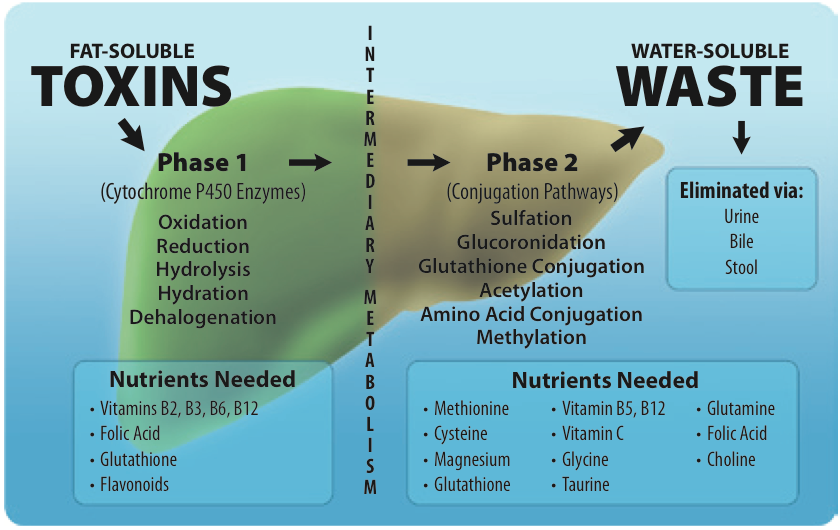
Step 1: Stop Taking In Toxins
Organic Foods
Studies show lower rates of infertility, birth defects, allergic sensitisation, ear infections and metabolic syndrome in those with habits of long-term organic food choices. [PMC7019963]
The nutrient content of produce can vary depending on the farming methods used and yearly conditions. However, analyses of various studies have consistently shown that organically grown foods generally contain higher levels of vitamin C, iron, magnesium, and phosphorus compared to their non-organic counterparts. Not only are these foods richer in essential nutrients, but they also contain fewer nitrates and pesticide residues.
Organic foods are also noted for having higher concentrations of key antioxidant phytochemicals such as anthocyanins, flavonoids, and carotenoids. Laboratory studies have consistently shown that organic fruits and vegetables have enhanced antioxidant activity and are more effective at blocking the mutation-causing properties of toxic compounds. Furthermore, some health advantages have been linked to consuming organic dairy products, such as a reduction in allergic dermatitis symptoms. [PMID: 20359265]
The Dirty Dozen And The Clean 15
Some foods should only be bought in their organic form, like bread. Produce is more variable in its chemical content so buying organic matters more with some types of produce than others. The Environmental Working Group has studied this question for many years and has created their trademarked “dirty dozen” and “clean fifteen” lists to help us keep things strait. Visit the Environmental Work Group at ewg.org to learn about their wide ranging work. The buttons that follow allow you to visit their dirty dozen and clean fifteen lists directly and sign up for their newsletters so that you can get ongoing help in clearing toxins from your life.
Soap, Body Lotion, Shampoo: Toxins Everywhere
Use the EWG’s Skin Deep Product Lookup. The Think Dirty App is a useful app for your phone that allows you to look up products by their barcodes for convenience. However it’s important to recognize the potential for bias in this app, which has been criticized for creating partnerships with brands.
Getting Rid Of The Non-Stick Pans
“Teflon” and non-stick pans were historically made with perfluorooctanoic acid (PFOA), a chemical linked to various health problems. The problem is that these chemicals stay in the body for a long time. Also, Teflon-coated pans can release harmful fumes when heated. But despite recent production changes, health concerns persist around non-stick cookware. For women who will someday become moms, it can never be too early to leave behind the non-stick cookware. Alternatives like stainless steel, cast iron, and ceramic cookware offer a safer option.
Household Cleaners Are A Source of Toxins
When you smell a fragrance, think of phthalates! Fragranced household cleaners commonly contain phthalates, known endocrine disruptors that can interfere with hormonal systems. Triclosan is an antimicrobial agent present in many antibacterial products. It can disrupt hormone function and contribute to antibiotic resistance. Manufacturers use alkylphenol ethoxylates (APEs) in laundry detergents and all-purpose cleaners, and these nonylphenol ethoxylates (NPEs) can interfere with hormones and are linked to various health issues.
Polishing agents for bathroom fixtures, sinks, and jewelry often contain ammonia, which can trigger respiratory issues and skin irritation. Chlorine bleach, a potent disinfectant and whitener, may harm the lungs and skin and can create dangerous gases when mixed with ammonia. Volatile organic compounds (VOCs) also exist in a wide array of cleaning products and can trigger a range of health problems from headaches to liver and kidney damage.
It’s time to check under the sink and decide what to keep and what to toss. Once again, the Environmental Work Group has put together a tremendous set of resources for looking up product safety. Check it out:
Non-toxic alternatives for household cleaning are a smart and sustainable choice. For example, a simple mix of vinegar and water can make an excellent all-purpose cleaner for countertops and windows. Baking soda serves as a powerful scrubbing agent for tough stains and can also freshen up carpets and rugs when sprinkled on, left for a few minutes, and then vacuumed up. Hydrogen peroxide can replace bleach for whitening and disinfection. Essential oils, like tea tree, lemon, and lavender, can add natural fragrance to homemade cleaners while also offering antimicrobial properties. Castile soap is a versatile, vegetable-based product that can be used for a range of cleaning tasks, from washing dishes to mopping floors.
How Pure is Your Water?
After lead from the water supply poisoned thousands of children in Flint Michigan, many people woke up to the fact that there are plenty of places that the water is unsafe. This issue is particularly acute in older cities with outdated plumbing systems. The second major concern is runoff from agricultural activities that introduce pesticides, herbicides, and fertilizers into the water sources. Atrazine is a common agricultural herbicide that is detected in water supplies due to runoff from farming activities. Studies have linked exposure to atrazine to preterm birth or low birth weight. Then, there are industrial pollutants and microplastics that find their way into the water supply.
These issues are widespread, so it pays to check on whether your water is safe. If you have your own well, you will want to think about the agricultural runoff. If you have city water, you’ll be able to look up your water quality by zip code. Once again, EWG has provided the resource:
If you find your water is not pure, a Guide To Water Filters is available on EWG.org as well. Whatever filtration system you choose, you make sure it is certified by the Water Quality Association or NSF.
Consider The Possibility of Lead
There are a lot of ways that a person can be exposed to lead aside from lead pipes causing water contamination. For example, if you live in a home that was built before 1978, there’s a high likelihood that it was painted with lead-based paints. Think about whether you have ever refinished old painted furniture that may have been painted with lead paints. Have you ever been involved in soldering with lead, such as in stained glass, of plumbing.
Crops can be contaminated with lead if they are grown in contaminated soil. Lead particles from leaded gasoline or paint can settle in the soil and remain there for years. Root vegetables like carrots, potatoes, and radishes, as well as leafy green vegetables, are especially prone to lead contamination. Therefore, washing vegetables thoroughly and peeling root vegetables can help reduce lead exposure.
It’s important to test any imported goods that might contain lead. These include toys, jewelry, cosmetics such as lipstick, and ceramics. The glazes used on some of these items may contain lead. Furthermore, some imported spices and foods have been detected to contain high levels of lead, and certain traditional remedies and cosmetics may also contain this harmful element.
Lead Testing
Lead tests check for harmful lead in your home. This is important in older homes with older homes built before 1978 when lead paint was finally banned. Lead is also present in some ceramic glazes, so don’t assume that the beautiful handmade ceramic coffee mug is safe. If someone got the glazes mixed up, it can contain significant amounts of lead.
Step 2: Testing
Labs To Learn Your Own Toxin Status
The purpose of pre-pregnancy toxin testing is to prevent the possibility of accidentally exposing your baby to toxins from the moment of conception throughout the most vulnerable stages of development in utero. The alarming truth is that the vast majority of chemicals in use today have had very little safety testing before entering the marketplace. We are in a population-wide experiment with these chemical exposures. At the same time, epidemiologists are seeing alarming increases in rates of autism, ADHD, and chronic diseases of all types.
Unless your parents and you have been exceedingly careful since childhood about what you have been exposed to, you may look back on a long history that might include microwaving food in plastics, breathing in household chemicals, scented air fresheners, questionable water, chemical laden stain-proof carpets, paint fumes, grocery store receipts and tatoos. Certain occupations are known for very high exposure risk.
If you are armed with the knowledge of your specific toxin status, you can give a sigh of relief, knowing you are safe, or work with your healthcare provider to take steps to clear the toxins from your body. There’s really no way to know what all you have floating around in your system unless you test your levels. Although these tests might be considered expensive by some standards, they are worth the investment. Future health problems can be far more costly to your family over the many years to come.
| Test | Description | Order Link |
| Total Tox-Burden Vibrant Wellness | URINE. The Total Tox-Burden panel contains the Environmental Toxins, Mycotoxins, and Heavy Metals tests. The Environmental Toxins profile screens for the presence of 39 toxic substances in your body. The Mycotoxins profile helps identify the presence of mycotoxins, toxic substances produced by certain types of fungi, in your body. The Heavy Metals profile identifies if you have been exposed to toxic levels of heavy metals. Report | Order Total Tox-Burden Test |
| Total Tox-burden + Organic Acids Vibrant Wellness | URINE. The panel combines the Environmental Toxins, Mycotoxins, Heavy Metals, and Organic Acids tests. The Environmental Toxins profile screens for 39 toxic substances in your body. The Mycotoxins profile helps identify the presence of mycotoxins, toxic substances produced by certain types of fungi, in your body. The Heavy Metals profile identifies if you have been exposed to toxic levels of heavy metals. The Organic Acids test measures the levels of certain organic acids in your body. Report | Order Total Tox-Burden + Organic Acids Test |
| Total Tox-Burden + PFAS Chemicals Vibrant Wellness | URINE. The Total Tox-Burden panel contains the Environmental Toxins, Mycotoxins, and Heavy Metals tests. The Environmental Toxins profile screens for the presence of 39 toxic substances in your body. The Mycotoxins profile helps identify the presence of mycotoxins, toxic substances produced by certain types of fungi, in your body. The Heavy Metals profile identifies if you have been exposed to toxic levels of heavy metals. Report | Order Total Tox-Burden + PFAS Test |
| NutriPro + Total Tox Vibrant Wellness | SERUM, URINE, WHOLE BLOOD, Phlebotomy required. This panel combines the NutriPro, Environmental Toxins, Mycotoxins, and Heavy Metals tests. It can help identify nutrient imbalances and toxin exposure. Report | Order NutriPro + Total Tox Test |
Step 3: Clearing Toxins From Your Body
Sweating It Out: Clear Some Toxins With a Sauna
The skin is your body’s largest organ, and it does more than just cover you up. We often think nothing can get through it, but that’s not true. Think medication patches. It’s not just a one-way street, either. Your skin can also get rid of stuff your body doesn’t need. This includes toxins, which your skin can push out. That requires sweating, whether it’s being outside in a warm climate, exercising, hot yoga, or by taking a long hot bath. Sauna is a very practical way to accomplish toxin excretion above and beyond what you can achieve with urine and bile.
Many people avoid sweating whenever they can. We recommend the opposite strategy. Engaging in activities that stimulate sweating, such as exercising or using a sauna, can help your body naturally detoxify itself. Turning off your air conditioning in the summer may help, not only in sweating out toxins but in cutting your utility bills as well. Sweat is not just composed of water; it also contains a variety of waste products and toxins that your body is trying to eliminate. These can include:
- Heavy Metals: Some studies have found that sweat can contain traces of heavy metals like lead, mercury, cadmium, and arsenic. These harmful substances can accumulate in the body from environmental exposure and are linked to all kinds of health problems.
- Bisphenol A (BPA): This endocrine-disrupting chemical can be excreted through sweat. Research has shown that BPA can lead to health problems, including neurological effects, heart problems, harm to the immune system, and certain types of cancer. But don’t buy BPA Free plastics either, because manufacturers of BPA Free plastics are usually substituting other potentially toxic, but less well understood chemicals. Unfortunately, the only safe choice is to get rid of every plastic exposure you can. Glass doesn’t leach chemicals.
- Phthalates: Used as plasticizers in many products from personal care items to vinyl flooring, phthalates are endocrine disruptors that can be eliminated via sweating.
- Polychlorinated Biphenyls (PCBs) and Polybrominated Diphenyl Ethers (PBDEs): These are types of persistent organic pollutants (POPs) that have been used in various industrial and chemical applications. They can accumulate in the body over time and be excreted through sweat.
- Ethylhexylglycerin: This is a common synthetic compound used in personal care products and can be eliminated via sweat.
- Volatile Organic Compounds (VOCs): These are a group of chemicals used widely in industry and found in many household products. Some VOCs can be excreted from the body through sweat.
While sweating can help remove these toxins, it’s important to note that the primary organs for detoxification in the body are the liver and kidneys. Sweating is just one of the ways your body can help eliminate toxins. Maintaining a balanced diet, staying hydrated, and getting regular exercise can also support your body’s natural detoxification processes.
Shop Sauna Blankets or Saunas Built for Two on Amazon
Sauna blankets offer an affordable at-home solution for those seeking the detoxifying and stress-relieving benefits typically associated with traditional saunas.
A home sauna offers the convenience of enjoying a soothing, sweat-inducing sauna experience anytime without needing to leave your house.
Nutrition Strategy For Optimal Toxin Clearance
Before we dive into the details, here are your top detox strategies in a nutshell. A healthy diet plays a crucial role in supporting our body’s natural detoxification processes. Here are some strategies:
- Hydrate: Water supports kidney function, one of our primary detoxification organs. Dehydration means toxins will tend to stay in the bloodstream longer. Divide your weight in pounds by 2 and that’s the number of ounces of water you will need as a basic rule.
- Eat a Balanced Diet: Consuming a variety of fruits, vegetables, lean proteins, and whole grains will usually provide most of the nutrients needed for your body to effectively process and eliminate toxins. The problem is that it’s too easy to order a pizza, drink a few glasses of wine, and have desserts or sweetened beverages.
- Limit Processed Foods: Highly processed foods often contain additives and preservatives that can be challenging for the body to process.
- Include Fiber: Dietary fiber can help you eliminate waste by binding toxins to fiber as they pass through the gut. That way the toxins leave the body through the digestive tract rather than being reabsorbed into the bloodstream. You’ll need 25-35 grams of fiber per day. These are present in high-fiber vegetables and flax or chia seeds as well as whole grains.
- Incorporate Detox Supporting Foods: Certain foods are known to support the body’s detox processes. These include cruciferous vegetables like broccoli and Brussels sprouts, garlic, berries, and foods rich in antioxidants. But don’t miss out on the detox food with 50 times the sulforaphane of the cruciferous vegetables: Broccoli Sprouts.
- Limit Alcohol: Excessive alcohol can overburden your liver, an organ critical to the body’s detoxification processes.
- Prioritize Gut Health: A healthy gut supports detoxification. Foods rich in probiotics, such as yogurt and fermented foods, can promote a healthy gut microbiome.
Nutrients That Help With Detoxification
There are several nutrient supplements that can support the body’s detoxification process:
- B Vitamins: B vitamins, especially B6, B12, and Folate, are important for the phase 1 and phase 2 detoxification processes in the liver.
- Glutathione: This is the body’s “master antioxidant”, which means it processes free radicals into harmless compounds. It also plays a vital role in recycling other antioxidants in the body and is essential for immune function and detoxification processes. Glutathione is made mostly in the liver and is made from the amino acids glutamate, glycine and cysteine.
- N-acetyl cysteine (NAC): This supplement is an easily absorbed form of the amino acid cysteine. Cysteine is needed as a building block of glutathione, and can therefore help increase the body’s glutathione levels so that there is a greater capacity to detoxify.
- Alpha-Lipoic Acid (ALA): This compound helps regenerate glutathione in the body, supporting detoxification.
- Supplements for Liver Health:
- Milk Thistle: This herb is often used to support liver health, as it’s believed to protect the liver from toxins and help it repair itself.
- Dandelion: Traditionally used as a liver tonic, dandelion may help enhance the liver’s ability to process toxins and support overall liver function.
- Artichoke Extract: It is believed to stimulate bile production and promote both liver and gallbladder function, helping the body to eliminate toxins.
- Schisandra: An adaptogenic herb, schisandra is believed to have liver-protective properties and assist with the body’s stress response.
- Probiotics: These can support the gut and its role in detoxification. They help maintain a healthy balance of good bacteria in the gut.
- Minerals:
- Magnesium: Important for many bodily functions, magnesium can also aid in detoxification by supporting liver function and the removal of toxins.
- Selenium: This essential mineral helps boost the antioxidant capacity of the body, aiding in detoxification.
- Zinc: This essential mineral is critical for maintaining a healthy immune system and may assist in heavy metal detoxification.
- Fiber: Most fibers will bind toxins while they move through the digestive tract. This allows them to be taken out of the body rather than being absorbed. Some fibers are soluble, making a gel that surround the toxin.
- Psyllium Husk: High in fiber, psyllium husk helps to support healthy bowel movements, which is a crucial part of the body’s natural detoxification process.
- Toxin Binders:
- Chlorella: This is a type of algae that binds to heavy metals in the body, aiding in detoxification.
- Activated Charcoal: Activated charcoal is often used in acute poisoning cases due to its ability to bind to certain toxins and prevent their absorption in the body.
- Bentonite Clay: This clay has been used for centuries to help remove toxins from the body when ingested or used on the skin.
- Turmeric (Curcumin): Curcumin, the active component in turmeric, is known for its anti-inflammatory and antioxidant properties. It can help stimulate bile production in the liver, assisting in the body’s detoxification process.
- Green Tea: Full of antioxidant compounds, green tea may assist in protecting the body from harmful toxins and support liver function.
- Garlic: Garlic contains sulfur compounds that are known to assist in detoxification processes.
- Spirulina: This blue-green algae is rich in vitamins and minerals and is believed to help remove heavy metals from the body.
- Beetroot: Beetroots are high in antioxidants and other beneficial compounds that support liver detoxification processes.
- Ginger: This root is thought to stimulate digestion and circulation, two processes that contribute to effective detoxification.
- Cilantro: Some research suggests cilantro may help remove heavy metals from the body.
To Sum It Up
Preparing for pregnancy involves more than just the typical prenatal care—it’s also about ensuring a toxin-free environment for your baby to develop. From chemicals and heavy metals in our food and water, to the pollutants in the air, our daily lives are filled with potential exposure to toxins. But by adopting a proactive approach—minimizing exposure, testing for common contaminants, and utilizing a detoxification plan—you can help safeguard your health and that of your future child.
The journey might seem overwhelming at first, but every step taken towards reducing toxin exposure and enhancing detoxification is a step towards a healthier pregnancy. Lifestyle changes and nutritional supplements can play a crucial role in this journey. They should be implemented under the guidance of healthcare professionals. By focusing on your well-being as a mother, you’re setting the stage for a healthier, happier pregnancy and laying a strong foundation for your child’s future health.
Notice: The NutriScape.NET site is intended for educational purposes and does not constitute the practice of health care advice, diagnosis, or treatment. Individuals should seek the advice of a qualified healthcare provider for any questions regarding personal health or medical conditions. Access to independently licensed Registered Dietitian Nutritionists can be found through our Telenutrition site.

 Scan Me!
Scan Me!
